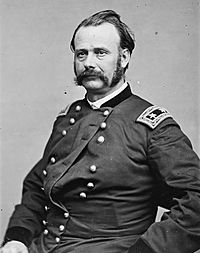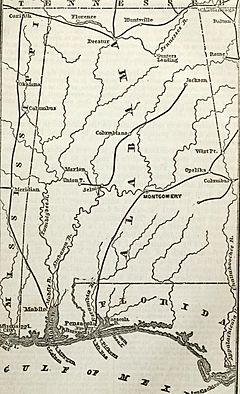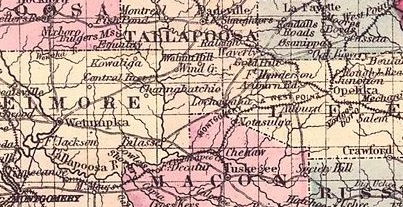Rousseau's Opelika Raid facts for kids
Quick facts for kids Rousseau's Opelika Raid |
|||||||
|---|---|---|---|---|---|---|---|
| Part of the American Civil War | |||||||
 Lovell Rousseau |
|||||||
|
|||||||
| Belligerents | |||||||
| Commanders and leaders | |||||||
| Lovell Rousseau | James Holt Clanton | ||||||
| Strength | |||||||
| 2,700, 2 guns | 300 | ||||||
| Casualties and losses | |||||||
| 50 men, 1 gun | 62 men, 30 miles of railroad infrastructure | ||||||
The Rousseau's Opelika Raid happened during the American Civil War from July 10 to July 22, 1864. About 2,700 Union cavalry soldiers, led by Major General Lovell Rousseau, rode deep into Alabama. Their mission was to destroy important Confederate supplies and property. The raid started in Decatur, Alabama, and faced very little resistance from Confederate forces.
The Union soldiers rode south-southeast across Alabama. They destroyed about 30 miles (48 km) of the Montgomery and West Point Railroad near Opelika, Alabama. After completing their mission, the Union cavalry turned northeast. They successfully joined Major General William Tecumseh Sherman's army near Marietta, Georgia, with very few losses. This raid was a big success for the Union side.
Contents
Why Atlanta Was Important in the Civil War
In 1864, the city of Atlanta was a key target for the Union Army. It was a major hub for four important railroads. These railroads connected the remaining parts of the Confederate States of America.
Atlanta's Railroad Connections
- The Western and Atlantic Railroad went north to Union-held Chattanooga, Tennessee.
- The Georgia Railroad went east to Augusta, Georgia.
- The Macon and Western Railroad went south, connecting to Savannah, Georgia.
- The Atlanta and West Point Railroad went west to Montgomery, Alabama. From Montgomery, boats could travel to Selma and Mobile, Alabama.
Atlanta also made weapons and military supplies. It stored many materials for the Confederate army. Confederate President Jefferson Davis knew that holding Atlanta was vital. It was a key point for sending supplies to General Robert E. Lee's army in the eastern part of the war.
Sherman's Plan to Attack Atlanta
On April 4, 1864, Union Army leader Ulysses S. Grant gave orders to General Sherman. Grant told Sherman to attack General Joseph E. Johnston's Confederate army. He also wanted Sherman to cause as much damage as possible to the enemy's war resources. Sherman chose Atlanta as his main goal.
Sherman planned to use his cavalry to cut the railroad lines around Atlanta. This would stop supplies from reaching the city and other Confederate armies. By July 4, 1864, Sherman had pushed Johnston's army back to the Chattahoochee River.
Orders for Rousseau's Raid
In late June or early July, Sherman ordered General Rousseau to prepare for a raid. Rousseau was to gather 2,500 cavalry soldiers. Many of them had special 7-shot Spencer repeating rifles. He also had two cannons and supplies.
Rousseau's mission was to start in Decatur, Alabama. He would ride south through Blountsville and Ashville. His main goal was to destroy the Montgomery and West Point Railroad between Tuskegee and Opelika.
How Soldiers Destroyed Railroads
To destroy the railroad, soldiers would lift the wooden ties on one side of the track. Then, they would break apart the metal rails. The wooden ties were piled up and set on fire. The iron rails were placed over the flames. When the middle of the iron rail became red hot, soldiers would twist the rails around telegraph poles or trees. This made the rails unusable. These twisted rails were called "Sherman's Neckties." After destroying the railroad, Rousseau was told to meet Sherman's army or go to Pensacola, Florida.
The Raid Begins
General Rousseau picked soldiers from several cavalry regiments for the raid. These included the 5th Iowa, 8th Indiana, 9th Ohio, 2nd Kentucky, and 4th Tennessee Cavalry. A small group with cannons also joined them. Rousseau divided his 2,700 horsemen into two groups.
The Union column left Decatur at noon on July 10. They rode southeast and reached Somerville that evening. Sherman's army had secured a position south of the Chattahoochie River. This allowed Sherman to pause his main campaign for a few days. He wanted to build up supplies and give Rousseau's raiders time to reach the Montgomery and West Point Railroad.
Journey Through Alabama
Rousseau's soldiers rode through Blountville, across Sand Mountain, and through Oneonta. On July 12, they met an advance group of the 4th Tennessee at Ashville. Late on July 13, the column crossed the Coosa River.
They had a short fight with a small Confederate force led by Brigadier General James Holt Clanton. Rousseau's force had only one soldier wounded. The Confederates lost 14 killed, 40 wounded, and 8 captured before they scattered. After this fight, Rousseau sent 300 soldiers who were not fit for the journey back to Guntersville. He continued the raid with 2,400 cavalrymen.
On July 14, the raiders reached Ohatchee. There, they destroyed the Cane Creek Ironworks and Janney Furnace. Rousseau ordered one of his cannons destroyed because it was slowing them down.
Destroying Confederate Resources
On July 15, Rousseau's command took over Talladega. The Union cavalry destroyed the depot, two weapons factories, and railroad cars full of army supplies. They also captured 143 wounded Confederate soldiers in a hospital and then released them.
On July 16, the Union column rode southwest and then southeast to Youngsville (now Alexander City). That evening, Rousseau's troops crossed the Tallapoosa River. They continued marching through Dadeville. Finally, they reached the Montgomery and West Point Railroad at Loachapoka. There, they cut the telegraph wires. Rousseau let his soldiers rest before they began tearing up tracks, burning ties, and twisting rails.
On July 18, Rousseau divided his forces into four groups to destroy more of the railroad.
- The 2nd Kentucky destroyed the railroad between Loachapoka and Notasulga.
- The 8th Indiana rode to Notasulga and destroyed track south of there.
- The 4th Tennessee rode to Chehaw Station and ruined the railroad from there to the north.
- A fourth group marched to Auburn. They drove away a few Confederates, burned supplies, and destroyed 3 miles (4.8 km) of railroad track north of town.
Camp Watts, a Confederate barracks, supply center, and hospital, was also burned. In Montgomery, Governor Thomas H. Watts gathered about 300 Confederate soldiers. This group included 54 cadets from the University of Alabama. They clashed with the 5th Iowa at Cheraw Station. However, when the 8th Indiana arrived with their repeating rifles, the Confederates had to retreat. Rousseau's soldiers continued destroying the railroad near Notasulga.
Raid's End and Impact
On the morning of July 19, Rousseau reorganized his force into three groups. One group continued destroying track near Notasulga. Another destroyed 2 miles (3.2 km) of track from Opelika toward Columbus, Georgia. The third group smashed switches and burned the depot at Opelika.
At noon, the Union raiders met up north of Opelika. Then, they headed north to LaFayette to stop for the evening. Rousseau's soldiers spent 36 hours destroying the railroad. Moving northeast, Rousseau's raiders crossed into Georgia. They rode through Carrollton and Villa Rica. They finally reached Powder Springs on July 22. The raid ended when they joined Sherman's army near Marietta.
Results of the Raid
Rousseau reported that he lost only 50 soldiers killed or captured during the entire raid. He claimed to have destroyed 30 miles (48 km) of railroad. This included stations, depots, bridges, and other railroad buildings. The Union raiders also burned or ruined huge amounts of cotton, food, and military equipment.
The Montgomery and West Point Railroad was so badly damaged that it could not be used for almost a month. Rousseau's arrival at Marietta brought 2,500 much-needed cavalry soldiers to Sherman's army. After the raid, these cavalrymen joined another cavalry division in Sherman's army. Rousseau then returned to his regular command in Nashville.





